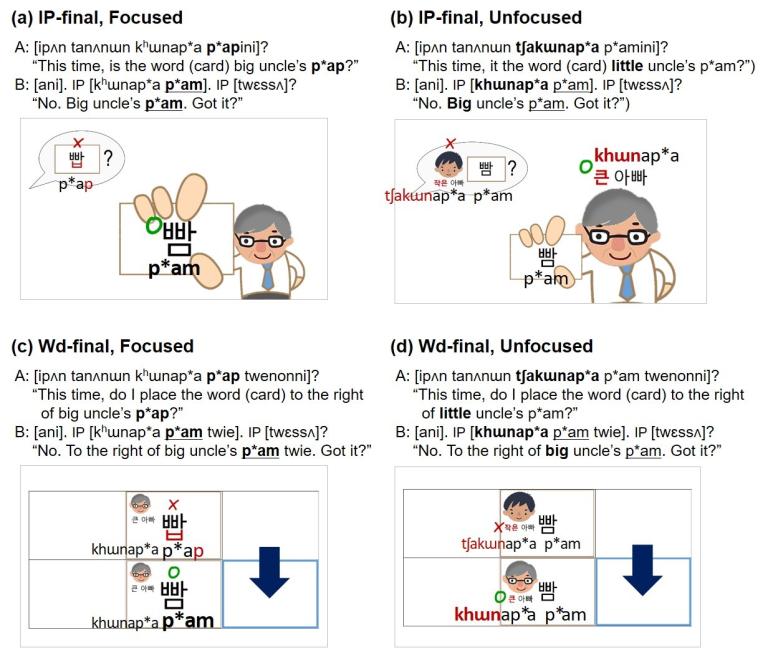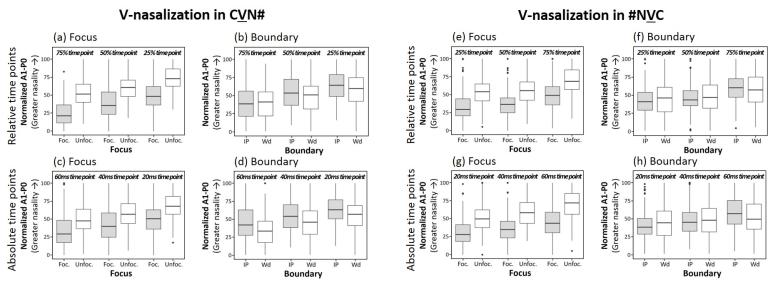Jang, Kim & Cho (2018) - 조태홍 교수 Prof. Taehong Cho
Supplementary data for Jang, Kim & Cho (2018)
Jang, J., S. Kim, & T. Cho (2018, under revision). Focus and boundary effects on coarticulatory vowel nasalization in Korean with implications for cross-linguistic similarities and differences. Journal of the Acoustic Society of America, Express Letter.
(The full citation information to be provided here when published)
A. Speech materials
1. List of test words
Table 1. A full list of eight monosyllabic target words in the nasal context (CVN, NVC) and additional eight monosyllabic control words in the oral context (CVC, CVC).
| Nasal context | Oral (control) context | |||
|---|---|---|---|---|
| CVN (CVC) |
빰 | [p*am] | 빱 | [p*ap] |
| 땀 | [t*am] | 땁 | [t*ap] | |
| 빤 | [p*an] | 빳 | [p*at] | |
| 딴 | [t*an] | 땃 | [t*at] | |
| NVC (CVC) |
맛 | [mat] | 빳 | [p*at] |
| 막 | [mak] | 빡 | [p*ak] | |
| 낫 | [nat] | 땃 | [t*at] | |
| 납 | [nap] | 땁 | [t*ap] | |
2. Example sentences
Each word in Table 1 was embedded in a carrier sentence in a mini discourse context as exemplified in Tables 2 and 3. The participants were asked to pretend that they were playing a kind of board game and to answer the pre-recorded questions with the intended responses following the visual clues (see Figure 1 below).
Table 2. Example sentences with target word p*am in the CVN# context. Target words are underlined and focused words are in bold.
| Boundary | Focus | Example sentences |
|---|---|---|
| IP-final | Focused | A: [ipʌn tanʌnɯn khɯnap*a p*apini]? “This time, is the word (card) big uncle’s p*ap?” B: [ani] IP [khɯnap*a p*am] IP [twɛssʌ]? “No. It’s big uncle’s p*am. Got it?” |
| Unfocused | A: [ipʌn tanʌnɯn tʃakɯnap*a p*amini]? “This time, is the word (card) little uncle’s p*am?” B: [ani] IP [khɯnap*a p*am] IP [twɛssʌ]? “No. It’s big uncle’s p*am. Got it?” |
|
| Wd-final | Focused | A: [ipʌn tanʌnɯn khɯnap*a p*ap twienonni]? “This time, do I place the word (card) to the right of big uncle’s p*ap?” B: [ani] IP [khɯnap*a p*am twie] IP [twɛssʌ]? “No. To the right of big uncle’s p*am. Got it?” |
| Unfocused | A: [ipʌn tanʌnɯn tʃakɯnap*a p*am twienon.ni]? “This time, do I place the word (card) right to little uncle’s p*am?” B: [ani] IP [khɯnap*a p*am twie] IP [twɛssʌ]? “No. To the right of big uncle’s p*am. Got it?” |
Table 3. Example sentences with target word mat in the CVN# context. Target words are underlined and focused words are in bold.
| Boundary | Focus | Example sentences |
|---|---|---|
| IP-initial | Focused | A: [ipʌn tanʌnɯn p*atsatʃʲin twienonni]? “This time, do I place the word (card) to the right of the picture of p*at?” B: [ani]. IP [matsatʃʲin twi]. IP [twɛssʌ]? “No. To the right of the picture of mat. Got it?” |
| Unfocused | A: [ipʌn tanʌnɯn matsatʃʲin aphenonni]? “This time, do I place the word (card) to the left of the picture of mat?” B: [ani]. IP [matsatʃʲin twi]. IP [twɛssʌ]? “No. To the right to the picture of mat. Got it?” |
|
| Wd-initial | Focused | A: [ipʌn tanʌnɯn ap*a p*atsatʃʲin twienonni]? “This time, do I place the word (card) to the right of dad’s picture of p*at?” B: [ani]. IP [a*pa matsatʃʲin twi]. IP [twɛssʌ]? “No. To the right of dad’s picture of mat. Got it?” |
| Unfocused | A: [ipʌn tanʌnɯn ap*a mat.satʃʲin aphenonni]? “This time, do I place the word (card) to the left of dad’s picture of mat?” B: [ani]. IP [a*pa matsatʃʲin twi]. IP [twɛssʌ]? “No.To the right of dad’s picture of mat. Got it?” |
3. Visual clues used to obtain semi-spontaneous speech in different experimental conditions in CVN#.
As shown in Figure 1 below, to obtain semi-spontaneous speech, the participants were provided with visual clues that illustrated the discourse situation on a computer screen, rather than the full written texts (given in Tables B and C).
The IP-final focused condition (Figure 1.a): There appeared two cards on the screen and a monosyllabic word was written on each of them (p*am vs. p*ap). The target word (e.g., p*am) appeared with an ‘O’ mark, and its phonologically contrasting word (e.g., p*ap) with an ‘X’ mark. The coda consonant of the contrasting word was in red to indicate that the contrast fell on the coda. The pre-recorded prompt sentence questioned whether the next word to pick would be the one of the two words (e.g., p*ap) shown on the screen. The participant (as Speaker B) was told to correct it by saying that the other, phonologically contrastive one would be what to pick, which induced contrastive (corrective) focus on the target word.
The IP-final unfocused condition (Figure 1.b): The test word (e.g., p*am) was written on both cards. This time, there appeared a picture of little uncle next to the word, and little vs. big were in red to indicate that the contrast fell on the modifier (big uncle’s vs. little uncle’s). The pre-recorded prompt sentence questioned whether the next word to pick would be little uncle’s card, and the subject was told to correct it by saying that it should be the big uncle’s card that was to be picked, so that the following target word was unfocused.
The Wd-final focused (Figure 1.c): There were two cards on a grid with a monosyllabic test word written on each of them (p*am vs. p*ap) with the picture of big uncle next to each word to indicate that the card belonged to big uncle (e.g., big uncle’s p*am vs. big uncle’s p*ap). The coda consonant of the contrasting word was in red to indicate that the contrast fell on the coda. In this context, the pre-recorded sentence questioned whether a newly picked card should be placed to the right of the contrasting word (e.g., to the right of big uncle’s p*ap). The subject was supposed to correct it by saying that it should be placed to the right of the target word (e.g., to the right of big uncle’s p*am) (as indicated by an arrow), which induced contrastive focus on the target. Since the place information (e.g., to the right of) followed the target word, the target word became non-final.
The Wd-final unfocused condition (Figure 1.d): The target word (e.g., p*am) was written on two cards on a grid. This time, the picture of little uncle appeared next to the target word, and little vs. big were in red to indicate that the contrast fell on the modifier (big uncle’s vs. little uncle’s). The pre-recorded prompt sentence questioned whether a newly picked card should be placed to the right of little uncle’s p*am. The subject (Speaker B) was supposed to correct Speaker A by saying that it should be placed to the right of big uncle’s p*am, so that the target word was unfocused.

Figure 1. Illustrations (visual clues) used in the experiment with the target word p*am in the CVN# context.
B. Schematization of vowel nasalization measurements
Figure 2 illustrates a change in the coarticulatory vowel nasalization for p*am during the vowel. When the vowel is more nasalized, the amplitude of F1 (A1) weakens and the amplitude of the low nasal peak (P0) is augmented. Therefore, a measurement point of a vowel with the greatest nasality will generate the lowest value of A1-P0. For example, Figure 2c shows that the value of A1-P0 is the lowest (because the amplitude of P0 is greater than A1) at the measurement point in the vowel nearest the nasal source where the greatest vowel nasalization is expected (Figure 2c; 25% away from the nasal). On the contrary, a vowel point with less nasality will show increased amplitude of F1 relative to the amplitude of P0, resulting in higher A1-P0 value (Figure 2a; 75% away from the nasal).

Figure 2. Schematization of vowel nasalization measurements of A1-P0 at different relative time points in CVN. Note that A1-P0 were also obtained at different absolute time points (i.e., 20ms, 40ms, 60ms before the vowel offset in CVN and after the vowel onset in NVC).
C. Variability in vowel nasalization
Figure 3 illustrates boxplots for Focus and Boundary effects in each time point of the vowel (relative, 25%, 50%, 75% points of the vowel; absolute, 20ms, 40ms, 60ms points from the nasal source—i.e., from the vowel onset in #NVC, and from the vowel offset in CVN# ).

Figure 3. Boxplots demonstrating variation of Focus (a, c, e, g) and Boundary (b, d, f, h) effects in each time points (relative, absolute) of the vowel.